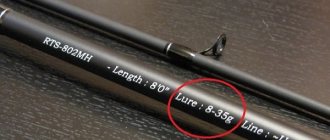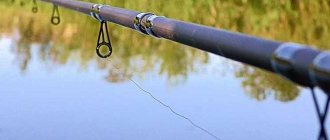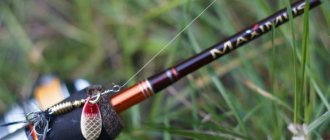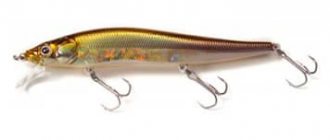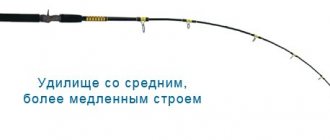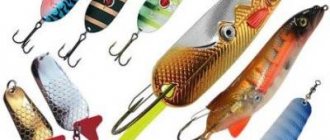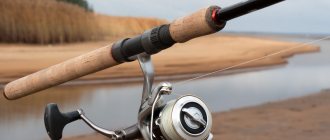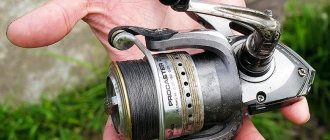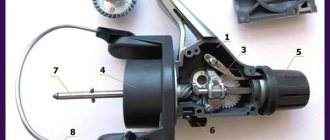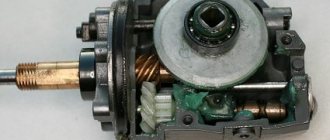Spinning is a sport fishing tackle. It is used in artificial and natural reservoirs. The fishing process involves throwing the bait, which is attached to a fishing line, in the desired direction. At first it may seem that there is nothing complicated about this, but in practice a completely different picture emerges. Only experienced fishermen get where they want to go the first time, and the casting distance can reach 50-80 m. To achieve this result, you need to practice properly.
What types of casts are there?
To deliver spinning bait to a specific point, anglers use several types. The main ones include:
- vertical;
- horizontal;
- pendulum;
- two hands;
- from under the hand;
- two hands over the head;
- over shoulder.
To be able to fish in any conditions, a beginner must learn all the species. Only such a thorough approach will help you reach fish sites both on a small, overgrown river and in a vast area of lakes and reservoirs.
Vertical, aka classic
On large and medium-sized reservoirs, the banks of which are free of dense vegetation, in most cases you can use the classic or, as it is also called, “vertical” type of casting.
Holding the spinning rod in a vertical position, the angler pulls its tip back and sends the bait to the intended point with a powerful send. This method has several advantages:
- ease of implementation;
- quite high accuracy;
- range.
The disadvantages include the mandatory presence of free space behind the fisherman's back. If the bank is overgrown with trees, performing a classic cast will be problematic. This type will also be ineffective in the case when a spinner or wobbler needs to be sent under a bush hanging over the pool. Since the bait flies high when performing a vertical send, you should pay attention to power lines that may pass over the water.
Holding the form with both hands
To increase the vertical casting distance you will need to use two hands. The right hand should be located in the area of the reel seat (if the person is right-handed), and the left hand should be at the bottom of the handle.
When performing a throw, the right hand moves forward slightly. Left - sharply pulled towards the body. This type is a power type, so there is an increased load on the tackle. To avoid breaking the spinning rod, do not wind the monofilament in such a way that it extends beyond the top edge of the spool. Otherwise, the cord will get tangled and stuck in the guide rings.
There are several other factors to take into account:
- the diameter of the guide rings is too small and the weight of the bait is insufficient, which will not allow you to cast it over a long distance;
- the use of an excessively thick fishing line greatly reduces not only the casting distance, but also the accuracy of casting;
- The winding of the monofilament should initially be tight and uniform.
When fishing on a river, you must first estimate the speed of the stream and understand which trajectory the bait will take, and only then cast it.
Horizontal or side
Having mastered the horizontal or side casting method, the fisherman will be able to fish in places where tree branches hang over his head. When using this method, the bait flies low above the water, so it is not difficult to send it under the opposite bank, densely overgrown with bushes.
The sequence of actions remains the same as when performing a classic throw. The only difference is that the rod is located in a horizontal plane. For a beginning spinning player, the main problem is the timely removal of the index finger, which fixes the monofilament. If you hurry or delay with this action, the bait will fly in the wrong direction.
Underhand throw
Throwing from under the hand is more often used in small bodies of water, when the bait needs to be placed in a certain place:
- window in aquatic vegetation;
- under an overhanging bush;
- next to a snag or fallen tree.
They also throw from under the arm in cases where space is limited behind and on the sides. The bait falls on the water with virtually no splash and does not scare wary fish. The process is divided into several stages:
- the line is released from the reel until the distance from the tip of the rod to the bait reaches 50 cm;
- the spinning rod is retracted back and down;
- the tackle is fed forward and upward.
The fishing line or cord is released at the moment when the spinning rod takes a horizontal position when fed forward. With certain skills, in this way you can very quickly catch the most promising points on the reservoir.
Pendulum for difficult areas
The pendulum type of casting is used for fishing in very cramped conditions, when it is impossible to make even a small swing. It works like this:
- the bait is lowered 20–30 cm from the tip of the spinning rod;
- the spinner or wobbler is swung;
- When the bait moves towards the selected point, the monofilament is released.
This method is quite complicated and takes a lot of time to master. However, having learned how to make such a cast, the fisherman will be able to fish in the most “strong” places, where large predators most often stand.
Two hands over your head
Throwing with two hands over the head is characterized by high accuracy and range of flight of the bait. To complete it you will need:
- place the tackle in front of you on slightly bent arms;
- open the line guide and fix the cord on your index finger;
- in a vertical position, vigorously pull the rod back, while holding it strictly above your head;
- without stopping the movement of the spinning rod, send a force forward.
The index finger releases the monofilament when the rod tip is at the top point. In this method, a large load is placed on the tackle, so the spinning test and the breaking load of the fishing line must correspond to the weight of the bait used. Otherwise, the likelihood of gear failure will be very high.
Bringing the spinning rod over your shoulder
If there are bushes or trees on both sides of the angler, and there is free space behind him, it makes sense to use an over-the-shoulder cast. To implement it you will need:
- take the tackle in such a way that the left hand is fixed at the end of the handle, and the right hand lies on the reel seat;
- move the rod back until the bait is 20–40 cm from the ground;
- make a sharp movement with the spinning rod in the direction of casting;
- release the line when the tackle is in a vertical position.
After the finger stops fixing the monofilament, the “stick” needs to be lowered down a little. This will reduce the friction of the fishing line on the guides and increase the casting distance.
Spinning casting basics
Before you begin practice, you need to consider the design of the spinning rod and determine how it works.
Theory
The design of a spinning rod ready for fishing consists of:
- rods with guides;
- coils;
- fishing lines;
- leash with bait.
The rod has a thin conical shape. The thick end of the rod is called the “butt”, the thin part is called the “top”. Fiberglass, plastic, and metal are used to make the fishing rod. There are several characteristics that determine the choice of fishing rod:
- Length – indicated in meters (for rods of European and domestic production) and in inches (for American models).
- Test – recommended weight of the bait to be thrown. It is mainly measured in grams. There is a maximum and minimum value. This indicator, in turn, affects the class.
- Ultra-light – test up to 5 grams.
- Light - test 7-15 grams.
- Medium – test 15-40 grams.
- Heavy - test 40 grams or more.
Action – indicates the modulus of elasticity of the rod. The devices are distinguished:
- fast action - only the tip of the rod bends;
- middle – slightly covers the middle part;
- slow - the entire structure bends under maximum load.
The rigid rod ensures sensitivity to the slightest vibration. You can quickly feel the fish and react in time. On the other hand, rigidity makes it difficult to cast over long distances. The more rigidity, the less whiplash.
Class is a general characteristic that combines the three previous indicators. Fishing rods are conventionally divided into six classes, which differ in the thickness of the fishing line used, the weight of the bait and the planned catch:
- UL - (ultralight) - ultra-light;
- L - (light) - light;
- ML - (medium light) - medium-light;
- M - (medium) - average;
- MH - (medium hard) - moderately heavy;
- H - (heavy) - heavy.
There are two types of coil:
- Inertial.
- Inertialess.
Inertial reels are the very first devices that began to be used for spinning rods. They are easy to use and can be repaired independently without the involvement of a specialist. This type of reel is not the most popular today. A variation are more complex multiplier reels - they have an improved design, but the principle of operation remains the same.
Inertia-free reels prevent tangling and excess line shedding due to the absence of spool torsion. After casting, the reel is fixed and controlled in the same way as an inertial one.
fishing line
The fishing line is chosen depending on the type of fish that you plan to catch. The smallest diameter is 0.25 mm. For training, a medium fishing line with a diameter of 0.5 mm is best suited. It is wound from the bottom side of the reel and threaded into rings located along the entire length of the rod. Then a leash with bait is tied to the end.
Learning process
It is better to start training to cast a spinning rod in a small body of water 2-3 meters deep. You should not try to throw the bait far; for the first time it is enough to throw it at a distance of about 30 meters and gradually increase the power of the throw.
You can cast from the right, left, bottom, side. First you need to master a few simple techniques. Later, you can experiment with other techniques, and then choose the most convenient method for yourself.
The easiest way is to make a side cast from right to left:
- Pull the bait to a distance of 30-40 cm from the tulip (a special ring at the end of the rod).
- Use your index finger to lightly secure the line.
- Swing back to the right.
- With effort, smoothly swing the rod forward and to the left. The line should move freely.
Vertical casting is also performed, but over the head, and the bait is pulled 15-25 cm towards the tulip.
After casting, you need to determine the depth: if you plan to fish near the bottom, lower the line, if closer to the surface, reel it in a little.
The most crucial moment is pulling out the prey. If the fish is small, pulling it towards you and removing it from the hook is quite simple. When catching large fish, it is better to use a landing net.
Technology in detail: subtleties and nuances
In order for the throws to always be long and accurate, a novice spinning player needs to know a number of existing nuances that will help him avoid common mistakes.
Where should the bait be when casting?
The distance from the spinning tulip to the bait is called overhang. To perform a high-quality cast, it should be about 30–40 cm. However, under certain conditions this figure has to be reduced or increased. The overhang length is reduced in the following situations:
- when fishing is carried out with a very short ultralight rod;
- if high accuracy is required at short distances;
- when the mass of the bait significantly exceeds the test range of the rod.
When fishing with floating wobblers, which have minimal weight, it is recommended to increase the length of the overhang to 70 cm, which will allow for better loading of the form. It should be remembered that the further the bait is from the tip of the spinning rod, the less accurate the casting becomes.
How to clamp the fishing line correctly
Many novice fishermen make the mistake of pressing the fishing line against the rod handle or reel spool while casting - this is incorrect. If the monofilament is fixed on the handle of the spinning rod, then when released, the amplitude of its vibrations will be very large, which will make it difficult for the fishing line to pass through the rings and significantly reduce the flight range of the bait.
If you hold the line on the top side of the spool when casting, then when it moves freely, it can damage your finger. When it comes to fishing with heavy loads, the resulting injury can be quite serious.
Monofilament must be fixed on the pad of a bent index finger located between the upper edge of the spool and the reel seat. Under the weight of the bait, the line is stretched and held securely during any manipulations with the tackle. When throwing, just straighten your finger a little.
Hold the spinning rod with one or two hands
When using long rods equipped with heavy baits, casting should always be done with two hands, one of which is located on the butt, and the other in the area of the reel seat. If this rule is not followed, a high-quality throw will not work.
If we are talking about fishing with light tackle of the “light” or “ultralight” class, then with certain skills you can use only one hand. For a novice spinning player who has not yet sufficiently mastered the throwing technique, it is better to always fix the tackle at two points.
How to cast a spinning rod with an inertial reel
A special feature of casting equipment using an inertial reel is the fisherman’s ability to slow it down correctly. There are no technical differences in how to properly cast a spinning rod with different types of reels. All types of throws using inertia-free reels are comparable to feeds equipped with an inertial reel.
Only horizontal casting is easier to do with inertia, due to the fact that it imparts less force to the movement of the reel, which subsequently requires less effort and reaction when braking it. With vertical casts, the feed force is much higher, as is the likelihood of beard loss due to errors in braking the rotation.
How to accurately send bait to one place
High casting accuracy can only be achieved through long practice. A novice fisherman needs to be prepared for the fact that at the initial stage the bait will not fly where he planned. There are several rules that can help in mastering an accurate throw:
- you should not make a large overhang of the bait;
- you need to focus your attention on accuracy, and not on the throw range;
- The weight of a spoon, wobbler or jig head should always be within the test limits of the rod.
At the initial stage of mastering spinning gear, it is recommended to choose a landmark on the opposite bank and cast at it. The range can be controlled by slowing down the line coming off the spool with your hand.
Blitz tips
Each specific type of fishing rod has its own individual equipment handling technique. Depending on the length and the accepted bending shape of the rod, the casting of the tackle and the style of casting will change - soft or sharp, short or sweeping.
Often, novice fishermen have a problem - braking the line. To prevent this from happening, it is necessary to reduce the friction of the fishing line on the equipment’s guide rings by lowering the rod slightly lower. So, if handled correctly, the spinning rod will perform the cast perfectly.
How to cast as far as possible
Casting range often determines the effectiveness of fishing, especially when it comes to catching wary fish in large bodies of water. This parameter is influenced by the following factors:
- spinning rod length;
- thickness of the fishing line used;
- wind strength and direction;
- aerodynamic qualities and weight of the bait.
The longer the spinning rod and the thinner the monofilament, the farther the tackle will fly. In headwind conditions, you should stop using wobblers and switch to more compact and heavier baits.
Basic mistakes when casting
At the initial stage of mastering spinning gear, most fishermen make the same type of mistakes, which do not allow for quality casting and often lead to the loss of bait and breakage of the rod. To avoid such troubles, you need to pay attention to a number of the following recommendations:
- Before performing a throw, you should make sure that the line guide is open;
- you never need to overload the tackle and install bait on it, the weight of which significantly exceeds the upper limit of the spinning test;
- Do not use too thick cords and fishing lines;
- There is no need to perform power throws unless necessary.
It is better to equip the rod with a reel with a low-profile spool - this will significantly increase the casting distance. It is not recommended to install the cheapest “inertia-free” Chinese-made spinning rods. Such products are not distinguished by uniform winding of the fishing line, which often leads to tangling of the monofilament and causes a lot of trouble for the fisherman.
